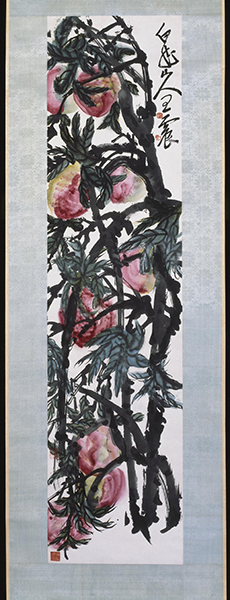Gem of the Month: Wang Zhen
This beautiful still life is representative of a period in Chinese art when Chinese artists began to be influenced by elements of Western art, before the Communist government was established. Many artists, like Wang Zhen, were inspired by Western abstraction, but applied the ideas within Chinese painting traditions. Let’s get ready for National Peach Month in August with Wang’s beautiful painting of the fruit.
 |
| Wang Zhen (1867–1938, China), The Fruit of Longevity (Peaches). Ink and color on paper, 52 ¼" x 12 ⅞" (132.8 x 32.7 cm). © 2022 Museum of Fine Arts, Boston. (MFAB-677) |
A native of Wuxing, Wang was one of the major proponents of a modern Chinese style. As a young man, he apprenticed in a mounting shop. In the 1880s, he studied under the pioneer Shanghai School painter Ren Yi (Ren Bonian, 1840–1896). While continuing to paint as an avocation, Wang became a successful businessperson in the Shanghai shipping industry.
Wang retired in 1906 to devote himself to painting. In 1911, he became a student of the painter, calligrapher, and seal carver, Wu Changshao (1844–1927), who only considered himself a member of the Shanghai School later in life. Wang gradually adopted Wu's broad and simple style of painting. It is possible that he painted works that were labeled with Wu's name.
Wang's style of rendering traditional landscape and bird-and-flower paintings in an expressionistic combination of ink dots and slashes may reveal his exposure to Western art on his many business trips to Japan, where he could have seen such work. In The Fruit of Longevity (Peaches), the complex intertwined vines contrast with the simplified outlines of the fruit. Wang's paintings were very popular in Japan.
During the Qing Dynasty (1644–1912), Chinese painting continued the traditional distinctions between the professional painters and the amateur/scholar painters (the literati). Once the Open Door Policy was forced on China by Western powers after the Opium War (1839–1842), five Chinese ports were open to trade with the West. Chinese artists began to learn substantially more about Western art at that time.
After the collapse of the Qing and establishment of the Chinese Republic in 1912, many young Chinese painters began to study Western art, first in Japan where schools were already established since the 1860s, and, after 1918, in Europe itself, mainly Paris. A few Chinese artists stayed in Europe. Those who returned to China did not find an eager audience for their Westernized styles. Some resumed traditional Chinese modes of expression, while some mixed traditional with western. Westernized styles were most popular in the cities of Shanghai and Tianjin.
Correlations to Davis programs: Explorations in Art 2E Grade 1: 1.7, 4.2; Explorations in Art 2E Grade 2: 1.3, 1.4; Explorations in Art 2E Grade 3: 5.6; Explorations in Art 2E Grade 5: 4.1, 4.2, 4.3; Explorations in Art 2E Grade 6: 2.7; A Personal Journey 2E: 2.6, 5.5; Experience Art: 4.1; Experience Painting: Chapter 4; Discovering Art History 4E: 4.3


Comments